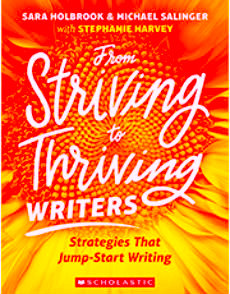Frameworks Jump-Start Your Students’ Writing
From Striving to Thriving Writers: Strategies That Jump-Start Writing
By Sara Holbrook and Michael Salinger with Stephanie Harvey
(Scholastic, 2018 – Learn more)

“We must trust ourselves as professional decision-makers, and we must trust students as powerful language learners.” Wow. I hope these words by Stephanie Harvey in the foreword of Strategies That Jump-Start Writing energize and empower you as they do me.
This vision is the essence of the From Striving to Thriving series, of which this book is the second. Trust yourself as a professional decision-maker.

My school’s fourth and fifth grade reading teachers have been studying Steph Harvey and Anne Ward’s From Striving to Thriving: How to Grow Confident, Capable Readers (the first book in the From Striving to Thriving series), so when I saw this book, I knew I had to have it!
Language centered lessons
This book is divided into three parts: Learning About Language, Learning Through Language, and Using Language to Learn About Self. There are a total of 27 frameworks divided among the three parts.
The authors describe a framework as a type of flexible scaffold provided to engage your students in writing. This approach enables students to add strategies to their toolkits that will, in turn, lead to more skillful writing. Co-author Michael Salinger describes the frameworks as training wheels that will be tossed aside as students get their balance (although I think a balance bike would be a better analogy – training wheels don’t actually teach balance!).
The authors mention how, when we teach writing, we often expect students to write in isolation in journals, or we have them responding to prompts, filling in worksheets or attempting to emulate mentor texts. The problem is, without an authentic purpose for writing, explicit instruction in how to write, and lots and lots of practice, all of these efforts are mostly wasted and we don’t see the results we desire.
The Frameworks in From Striving to Thriving provide students with an authentic purpose for writing and step-by-step instructions on how to go about doing it. There is also always a mentor text; however, using a mentor text without modeling is not effective. This book shows students exactly “how the process works and how to be writers before they venture out on their own.”
Writing, speaking and listening
Additionally, there is more than one opportunity built into every Framework for speaking and listening. The authors state, “As Richard Allington (2012) asserts, ‘If we wish to help children and adolescents become thoughtfully literate, classroom talk around texts is critical.’” Opting out of share time is not an option. The classroom is a safe place. If they don’t learn to speak in their own voice there, where will they learn? That said, there are many different forms of sharing, so reluctant students are able to ease into it.
On pages 11-16, the authors answer a few questions they’ve been asked about their approach. One of those questions is if the Frameworks will kill students’ creativity. Short answer: no. It’s okay to give our students assigned topics and structured prewrites. In fact, “too much choice can be overwhelming to striving writers.”
The Frameworks encourage topics that are inspired by your content area lessons. In this way, students are building content area knowledge, literacy, and writing skills all at the same time! This design builds students’ confidence as they write to suit their own purposes.
Some of the other questions that are addressed are: helping students with diverse interests and abilities; using mentor texts in the best possible way; and finding the time to implement the writing frameworks with an already overcrowded curriculum.
Online resources to support frameworks
The Framework Process is described on pages 17-25. As you’re reading these pages, you can also refer to the videos that are provided at the password-protected Scholastic resources site for the book. These videos show the authors using the framework with a classroom of students. Also provided at this website are author interviews, lesson slides, student GO (graphic organizer) sheets, and other indispensable resources.
The remainder of the book—pages 30-263—are Frameworks 1-27. These are the actual lessons that you will use with your students. Let me say that again. The rest of the book has the actual lessons that you will use with your students!! It’s all right there, at your fingertips!!
Each Framework gives you a timeframe, materials list (most are also available at that Scholastic website), a “Why Teach This?” and a “Content Area Connections.” They also have a “Steph Reflects” section where Steph Harvey comments on the Framework and why it’s important. The remainder of the pages go through how to teach the Framework. So, so practical!
At the beginning of the book there’s a “Focus Skills by Framework” chart that shows what skills are taught in each Framework, such as persuasive, descriptive, vocabulary, figurative language, etc. There’s also a “Spectrum of Thriving Writer Behaviors, Attitudes, and Understandings” chart.
This book has lessons for K-6 and up. Although all 27 of the lessons can be used with upper level students, only 3 lessons are K level; 10 are 1st grade; 11 are 2nd grade; and 13 are 3rd grade.
Pam Hamilton is an intermediate literacy coach in Middlebury, Indiana. She enjoys working alongside teachers as they instill a love of literacy in their students. She also enjoys being wife to Steve and mama to two beautiful daughters, Allie and Peyton.































Thanks for the review, you’ve hit upon the intent of this resource precisely and concisely!